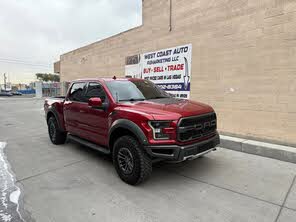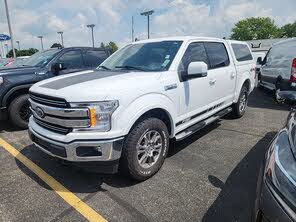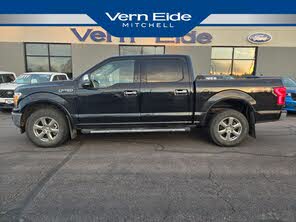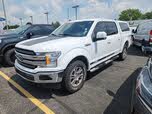2020 Toyota Tundra vs 2019 Ford F-150
Overview | |
MSRP$28,155 | MSRP$33,575 |
Listings5436 | Listings511 |
Ratings & Reviews | |
User Reviews | User Reviews |
Expert reviews8.2 out of 10 | Expert reviews5.3 out of 10 |
Pros
Cons
| |
2019 Ford F-150 Reviews SummaryThe notion of "luxury trucks" might seem a little weird if you haven’t bought a new truck in 20 years, but anyone who's been in the market lately should be more than familiar with the idea. Not only that, they should be more than accustomed to the sticker shock associated with these high-end, luxury pickups. Some old-school types will scoff at how trucks have gotten soft or too expensive (or both), but good automakers build the cars and trucks people want, and shoppers have been snatching luxury trucks as fast as they can be built and shipped. These "soft" trucks offer a template for seemingly dozens of purposes. They can tow, haul, carry people and goods, play road-trip family car, and even be the ride for a night on the town. The Chevy Silverado, GMC Sierra, and Ram 1500 all got redesigned for 2019, while the F-150 was last updated in 2018, following a full redesign for 2015. There are a few modest feature updates for 2019 as well, but will that be enough when the F-150’s main competition is all-new for the same model year? | |
2020 Toyota Tundra Reviews SummaryToyota hasn’t completely redesigned the Tundra full-size pickup truck since George W. Bush was the president of the United States. Let that sink in for a moment. What that means for you is that a 2020 Toyota Tundra should prove utterly bulletproof in terms of reliability. What this also means is that a 2020 Toyota Tundra is uncompetitive in numerous ways. | |
No video found | |
Popular Features & Specs | |
Engine3.3L 290 hp V6 Flex Fuel Vehicle | Engine5.7L 381 hp V8 |
Drive Train4X2 | Drive Train4X2 |
Seating Capacity3 | Seating Capacity6 |
Horsepower | Horsepower381 hp @ 5600 rpm |
MPG City19 | MPG City13 |
MPG Highway25 | MPG Highway18 |
Engine | |
Engine Name3.3L 290 hp V6 Flex Fuel Vehicle | Engine Name5.7L 381 hp V8 |
Torque | Torque401 lb-ft @ 3600 rpm |
Horsepower | Horsepower381 hp @ 5600 rpm |
Drivetrain4X2 | Drivetrain4X2 |
Fuel Economy | |
MPG City19 | MPG City13 |
MPG Highway25 | MPG Highway18 |
Interior | |
Seating Capacity3 | Seating Capacity6 |
Safety | |
Front Crash Overall4 | Front Crash Overall4 |
Side Crash Overall5 | Side Crash Overall5 |
Dimensions & Capacity | |
Bed Length78.9 in | Bed Length78.7 in |
Cargo Space12.1 cu ft | Cargo Space |
Curb Weight4069 lbs | Curb Weight5170 lbs |
Height75.5 in | Height76.0 in |
Length209.3 in | Length228.9 in |
Width96.8 in | Width79.9 in |
Wheelbase122.4 in | Wheelbase145.7 in |
Maximum Payload1990 lbs | Maximum Payload1730 lbs |
Number of doors2 | Number of doors4 |
Maximum Towing Capacity9200 lbs | Maximum Towing Capacity10200 lbs |
Standard Towing Capacity5100 lbs | Standard Towing Capacity10200 lbs |
Overview | ||
MSRP | $28,155 | $33,575 |
Listings | ||
Ratings & Reviews | ||
User reviews | ||
Expert reviews | 8.2 out of 10Read full review | 5.3 out of 10Read full review |
Pros & cons | Pros
Cons
| |
Summary | The notion of "luxury trucks" might seem a little weird if you haven’t bought a new truck in 20 years, but anyone who's been in the market lately should be more than familiar with the idea. Not only that, they should be more than accustomed to the sticker shock associated with these high-end, luxury pickups. Some old-school types will scoff at how trucks have gotten soft or too expensive (or both), but good automakers build the cars and trucks people want, and shoppers have been snatching luxury trucks as fast as they can be built and shipped. These "soft" trucks offer a template for seemingly dozens of purposes. They can tow, haul, carry people and goods, play road-trip family car, and even be the ride for a night on the town. The Chevy Silverado, GMC Sierra, and Ram 1500 all got redesigned for 2019, while the F-150 was last updated in 2018, following a full redesign for 2015. There are a few modest feature updates for 2019 as well, but will that be enough when the F-150’s main competition is all-new for the same model year? | Toyota hasn’t completely redesigned the Tundra full-size pickup truck since George W. Bush was the president of the United States. Let that sink in for a moment. What that means for you is that a 2020 Toyota Tundra should prove utterly bulletproof in terms of reliability. What this also means is that a 2020 Toyota Tundra is uncompetitive in numerous ways. |
Video | No video found | |
Popular Features & Specs | ||
Engine | 3.3L 290 hp V6 Flex Fuel Vehicle | 5.7L 381 hp V8 |
Drive Train | 4X2 | 4X2 |
Seating Capacity | 3 | 6 |
Horsepower | 381 hp @ 5600 rpm | |
MPG City | 19 | 13 |
MPG Highway | 25 | 18 |
Engine | ||
Engine Name | 3.3L 290 hp V6 Flex Fuel Vehicle | 5.7L 381 hp V8 |
Torque | 401 lb-ft @ 3600 rpm | |
Horsepower | 381 hp @ 5600 rpm | |
Drivetrain | 4X2 | 4X2 |
Fuel Economy | ||
MPG City | 19 | 13 |
MPG Highway | 25 | 18 |
Interior | ||
Seating Capacity | 3 | 6 |
Safety | ||
Front Crash Overall | 4 | 4 |
Side Crash Overall | 5 | 5 |
Dimensions & Capacity | ||
Bed Length | 78.9 in | 78.7 in |
Cargo Space | 12.1 cu ft | |
Curb Weight | 4069 lbs | 5170 lbs |
Height | 75.5 in | 76.0 in |
Length | 209.3 in | 228.9 in |
Width | 96.8 in | 79.9 in |
Wheelbase | 122.4 in | 145.7 in |
Maximum Payload | 1990 lbs | 1730 lbs |
Number of doors | 2 | 4 |
Maximum Towing Capacity | 9200 lbs | 10200 lbs |
Standard Towing Capacity | 5100 lbs | 10200 lbs |
The 2019 Ford F-150 exhibited a continuation of innovative design with its emphasis on lightweight aluminum body panels, a feature that not only differentiated it from competitors but also sparked discussions in the automotive industry. While some critics, including competitors like General Motors, questioned the durability of aluminum, Ford's commitment to this material has shown resilience and functionality, especially considering similar materials are being incorporated into newer models from other manufacturers. The F-150 featured a series of trim levels ranging from the base XL to the luxurious Limited, each offering upgrades and unique features, such as the King Ranch’s distinctive interior and the Raptor’s off-road capabilities. The design elements remained consistent with the traditional robust aesthetics, meant to appeal both to the practical and luxury-seeking truck owner.
In contrast, the 2020 Toyota Tundra embraced a more straightforward aesthetic combined with functional ruggedness, particularly evident in the TRD Pro model tested. The Tundra maintained a traditional truck design that has aged decently, with a focus on size and durability rather than finesse. Interior elements, though less modern compared to rivals, provided substantial space and practicality, especially in the CrewMax version, which offered expansive interior room that impressed passengers of all sizes.


















With a diverse engine lineup, the 2019 Ford F-150 demonstrated versatility and power across its models. The introduction of a 3.0-liter turbodiesel V6 engine in the King Ranch trim highlighted a balance of moderate horsepower and substantial torque, suitable for considerable towing needs up to 11,400 pounds. Other engines, including the potent 450-hp 3.5-liter EcoBoost V6 available in the Limited trim, catered to varying demands from fuel efficiency to raw power. The strategic use of a 10-speed automatic transmission across most trims enhanced performance efficiency and driving experience.
Conversely, the 2020 Toyota Tundra stuck with a single-engine choice across all trims, a 5.7-liter V8 that delivered a reliable 381 horsepower and 401 pound-feet of torque. Although it lacked variety, this engine supported a strong towing capacity up to 10,200 pounds and embodied Toyota’s reputation for reliability. However, the older 6-speed automatic transmission and the generally louder engine noise presented a less refined ride compared to more modern counterparts.
Both trucks offered configurations suitable for various uses, from work-focused setups to family-friendly layouts. The 2019 F-150’s multiple cab and bed configurations, including the spacious SuperCrew, highlighted Ford’s commitment to providing options tailored to diverse needs. Interior storage and passenger space were generously proportioned, adapting smartly for cargo without compromising comfort.
The Tundra’s CrewMax configuration mirrored this approach with immense cabin space that easily accommodated adults and children alike. However, its interior storage solutions were not as versatile or modern as those found in the F-150, and the absence of advanced bed features such as those available in competitors limited its utility to simpler, albeit robust, functions.
Technology in the F-150 ranged from basic offerings in the XL trim to advanced integration in higher trims, including the popular Sync 3 infotainment system with support for smartphone integration through Apple CarPlay and Android Auto. Additional luxuries in higher trims, like Wi-Fi hotspots and premium sound systems, marked Ford’s F-series as not only work-ready but also tech-savvy.
The Tundra’s technology features, while sufficient, did not break new ground. The infotainment system, even in its updated form, felt somewhat outpaced by competitors, though it included essential functions like Apple CarPlay, Android Auto, and a capable JBL sound system in higher trims. The functional but uninspired tech offerings highlighted the Tundra’s need for a modern overhaul.
Ford’s F-150 came equipped with extensive safety features across the lineup, from standard airbags and a reversing camera to optional driver-assistance technologies in higher trims. The availability of advanced features like a 360-degree camera system underscored Ford’s focus on comprehensive safety.
Toyota’s Tundra included standard Toyota Safety Sense and other advanced safety aids, but its overall safety ratings from IIHS and NHTSA painted a mixed picture, showing room for improvement in crash-test performance and advanced safety technology implementation.
CarGurus highlights

According to CarGurus experts, the overall rating for the 2019 Ford F-150 is 8.2 out of 10, while the 2020 Toyota Tundra scores 5.3 out of 10. With its higher score, the F-150’s blend of power, luxury, and safety features places it ahead of the Tundra, making it the recommended choice for consumers seeking a well-rounded and versatile pickup truck.
Choose the 2020 Toyota Tundra if:
- You appreciate straightforward, durable truck design with proven reliability.
- A single, powerful V8 engine meets your performance needs without the need for variation.
- You prefer a simpler technology setup that covers all basic needs.
Choose the 2019 Ford F-150 if:
- You value a diverse range of engine options and advanced technologies.
- You require a truck with extensive safety features and dependable performance.
- Luxury and comfort are priorities alongside traditional truck capabilities.
CarGurus highlights

According to CarGurus experts, the overall rating for the 2019 Ford F-150 is 8.2 out of 10, while the 2020 Toyota Tundra scores 5.3 out of 10. With its higher score, the F-150’s blend of power, luxury, and safety features places it ahead of the Tundra, making it the recommended choice for consumers seeking a well-rounded and versatile pickup truck.
Choose the 2020 Toyota Tundra if:
Shop Now- You appreciate straightforward, durable truck design with proven reliability.
- A single, powerful V8 engine meets your performance needs without the need for variation.
- You prefer a simpler technology setup that covers all basic needs.
Choose the 2019 Ford F-150 if:
Shop Now- You value a diverse range of engine options and advanced technologies.
- You require a truck with extensive safety features and dependable performance.
- Luxury and comfort are priorities alongside traditional truck capabilities.

By: CarGurus + AI
At CarGurus, our team of experienced automotive writers remain at the heart of our content operation, conducting hands-on car tests and writing insightful guides that are backed by years of industry experience. To complement this, we are harnessing AI to make our content offering more diverse and more helpful to shoppers than ever. To achieve this, our AI systems are based exclusively on CarGurus content, ratings and data, so that what we produce is both unique to CarGurus, and uniquely helpful to car shoppers.





































